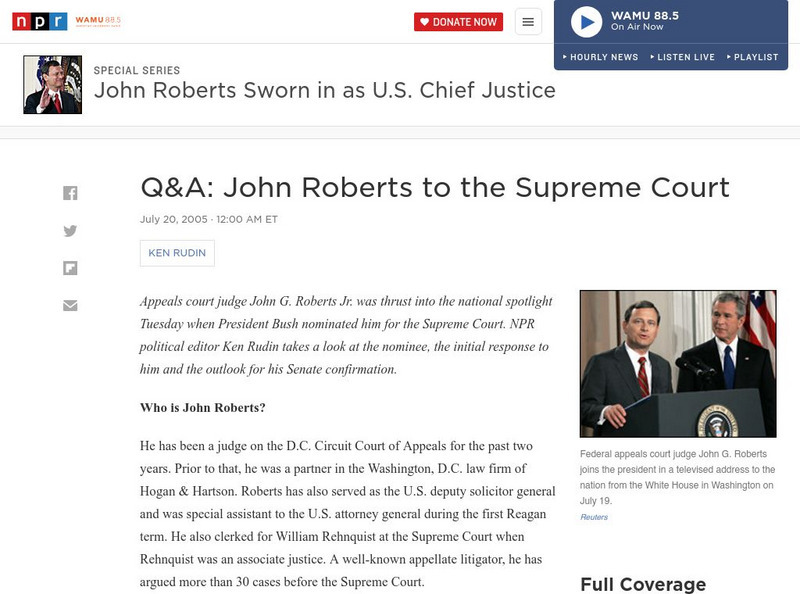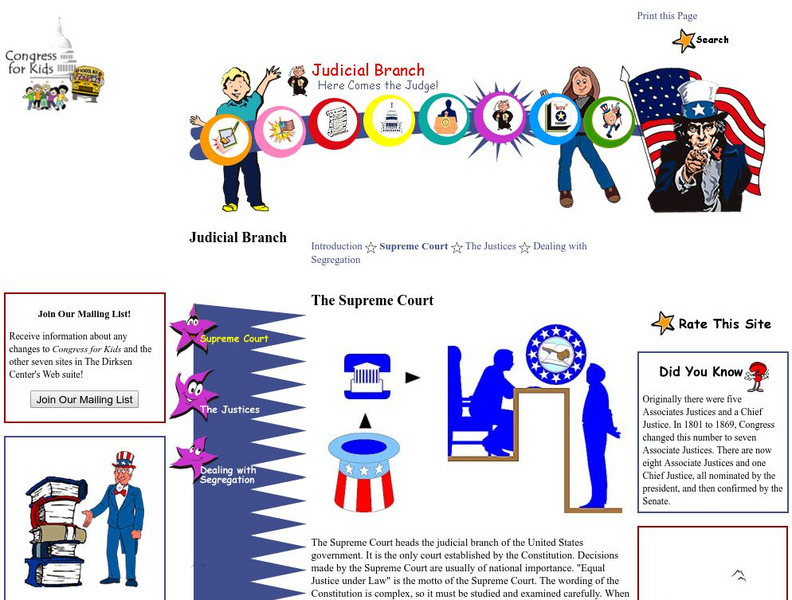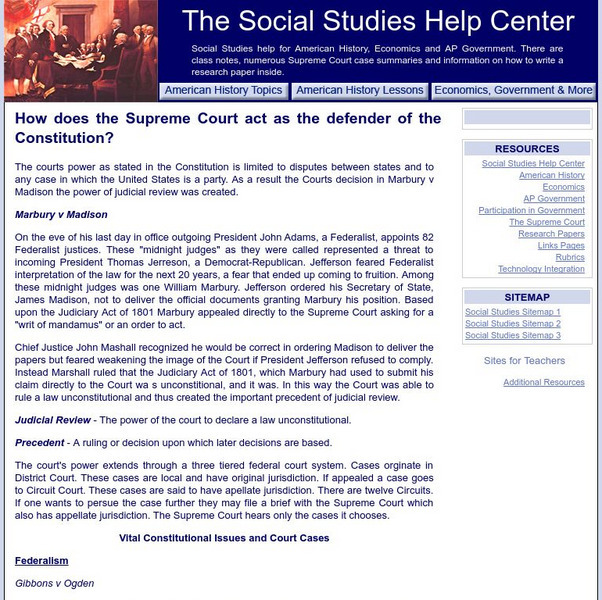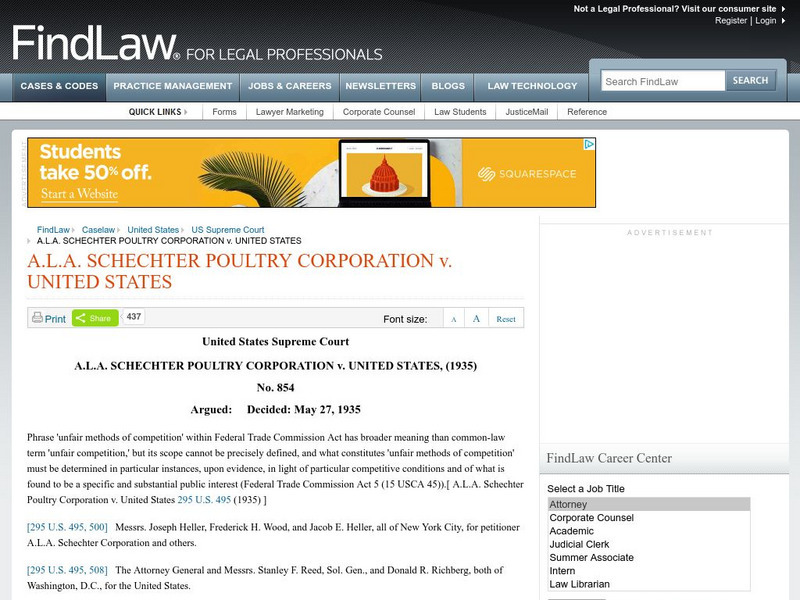Annenberg Foundation
Annenberg Learner: Democracy in America: The Courts: Our Rule of Law
This unit provides a comprehensive look into the value of the U.S. court system as a means to maintain the safety of American citizens. Offers video, readings, web resources, and activities.
PBS
Now With Bill Moyers: Supreme Court and Freedom of Speech
Brief descriptions of several case studies involving decisions by the Supreme Court concerning First Amendment rights, especially freedom of speech.
Thomson Reuters
Find Law: u.s. Supreme Court: Marbury v. Madison (1803)
This resource contains the full text of the 1803 Supreme court case, Marbury v. Madison opinion.
NPR: National Public Radio
Npr: Q&a: John Roberts to the Supreme Court
Background of John Roberts is given in a Q&A format. Roberts' biography, possible impact on court, stance on issues, and more. Article is from July, 2005.
Yale University
Yale New Haven Teachers Institute: Supreme Court Rules on School Desegregation
This thoughtful unit explores the history of school desegregation legislation, including a discussion of the impact of the Plessy v. Ferguson and Brown v. Board of Education decisions. A six-week plan of lessons, along with other sample...
iCivics
I Civics: Appellate Courts: Let's Take It Up
Students learn what happens in appellate-level courts and how those courts operate differently from the trial courts most people are familiar with from watching television. They find out what happens when someone takes a case all the way...
Scholastic
Scholastic: John Doe in a u.s. Court
This site from Scholastic provides a well-written essay describes the federal court system and its jurisdiction including the '7 steps in justice.'
iCivics
I Civics: The Judicial Branch
Learners will learn about the federal and state courts and what they do. They will explore the courts' role in fairly settling disputes and administering justice, and the unique role of the U.S. Supreme Court in interpreting the U.S....
PBS
Pbs Teachers: Advice and Consent: Supreme Court Nominations (Lesson Plan)
A lesson that explains the role of checks and balances in U.S. system of government. Students will describe the process of selecting justices for the Supreme Court, will examine past Supreme Court cases, and will discuss how the Supreme...
Scholastic
Scholastic: Bios of the Supreme Court Justices
Short biographical sketch of each current member of the US Supreme Court.
Ducksters
Ducksters: Us Government for Kids: Judicial Branch the Supreme Court
Kids learn about the Judicial Branch of the United States Government. Judges and the Supreme Court.
Other
Supreme Court Rules in Exclusionary Rule Case
Description of a 1995 court case, Arizona v. Evans, in which the ruling was reversed by the U.S. Supreme Court and how the case applies to the Exclusionary Rule.
Cool Fire Technology
Cool Fire Technology: Supreme Court Decisions
A listing of the most significant Supreme Court cases in the nineteenth and twentieth centuries with brief summaries of how they impacted on federalism.
The Dirksen Congressional Center
Congress for Kids: The Supreme Court
An overview of the Supreme Court: how it works, its role, people appointed to it, and more.
Social Studies Help Center
Social Studies Help Center: The Supreme Court as Defender of the Constitution
This site gives you examples of court cases demonstrating how the Supreme Court upholds the constituion. It also includes links to further information.
Thomson Reuters
Find Law: u.s. Constitution: Schechter Poultry Corporation v. United States (1953)
This resource contains the full text of the opinion delivered by Chief Justice Hughes of the Supreme Court. This case was about unfair competition.
University of Groningen
American History: Documents: Pollock v. Farmer's Loan and Trust Co. 1895
Read the complete text of the landmark Supreme Court case of Pollock v. Farmer's Loan and Trust Co. 1895.
University of Groningen
American History: Documents: u.s. V. e.c. Knight and Co. 1895
View the complete text of the 1895 Supreme Court case of the United States v. E.C. Knight and Co. which concerned the Sherman Antitrust Act.
iCivics
I Civics: Marbury v. Madison (1803)
This mini-lesson covers the basics of the Supreme Court's decision that affirmed the Court's power of judicial review. Students learn how Congress tried to add to the Supreme Court's Constitutional power, how the Supreme Court rejected...
iCivics
I Civics: West Virginia State Board of Education v. Barnette (1943)
This mini-lesson plan covers the basics of the Supreme Court's decision that it was unconstitutional for a state to force learners to salute the flag and recite the Pledge of Allegiance. Students learn how the interests of national unity...
iCivics
I Civics: Bethel School District v. Fraser (1986)
This mini-lesson covers the basics of the Supreme Court's decision that established a school's ability to prohibit inappropriate student language on campus. Students learn about the First Amendment right of free speech, and explore the...
iCivics
I Civics: Tinker v. Des Moines (1969)
This mini-lesson covers the basics of the Supreme Court's decision that extended First Amendment protections to students in the classroom. Students learn about the concept of symbolic speech and how students gained the right to engage in...
iCivics
I Civics: Gideon v. Wainwright (1963)
This mini-lesson covers the basics of the Supreme Court's decision that gave defendants in state criminal courts the right to a lawyer. Students learn about the 6th Amendment right to a lawyer, why the right is important, and how the...
iCivics
I Civics: Plessy v. Ferguson (1896)
This mini-lesson covers the basics of the Supreme Court's decision that it was constitutional to keep black and white people segregated as long as the accommodations for each race were "equal." Students learn about the concept of...















